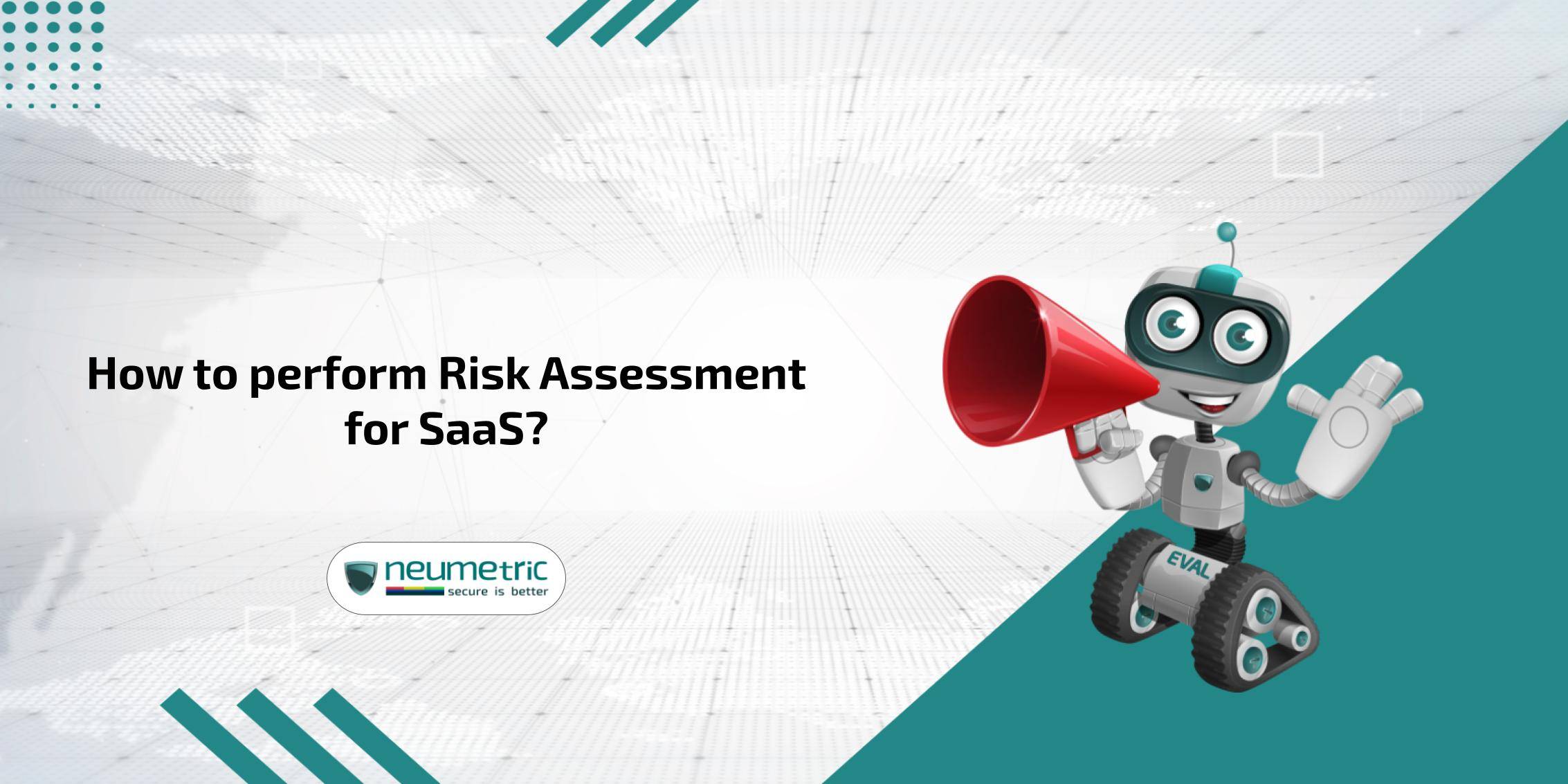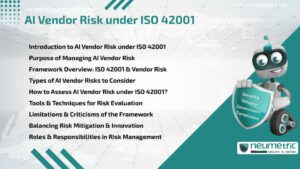Table of Contents
ToggleHow to perform Risk Assessment for SaaS?
Introduction
Picture this: Software as a Service or SaaS, is like having your favorite tools accessible anytime, anywhere, without the hassle of installation or maintenance. It’s revolutionizing how businesses operate by offering software solutions on a subscription basis. Think Gmail, Dropbox or even your go-to project management tool—all readily available through the cloud. Now, why is this SaaS revolution such a big deal? Well, it’s transforming the way companies function. Instead of buying & managing software on individual computers, they’re opting for these cloud-based services, freeing up resources & enhancing flexibility. It’s the future of software.
But here’s the kicker: along with this fantastic innovation comes a new set of risks. That’s where risk assessment steps in. Think of it as your guardian angel, safeguarding your data & operations in this digital universe. In this Journal, we’re diving deep into the critical realm of SaaS risk assessment. We’ll explore why it’s absolutely crucial in today’s tech landscape, the different types of risks lurking around SaaS platforms & most importantly, how to conduct a thorough risk assessment that could potentially save your business from unforeseen disasters.
We’ll break down the process into manageable chunks, covering everything from understanding the nature of SaaS risks to practical frameworks & tools for assessment. Along the way, we’ll highlight best practices to guide you through the maze of SaaS risk assessment.
Understanding SaaS Risks
So, here’s the scoop: SaaS comes with a mixed bag of risks that could potentially rock the boat for businesses. These risks aren’t just abstract concepts—they’re real threats that can shake up your company’s stability.
What Are SaaS Risks & How Do They Affect Businesses?
Imagine a treasure trove of data—customer info, financial records, the works—floating in the cloud. Now, if this treasure isn’t securely locked away, you’ve got a risk fest on your hands. SaaS risks are like those sneaky burglars trying to break into this treasure chest. They can lead to data breaches, leaks & all sorts of chaos.
The impact? Well, it’s a mixed bag of trouble. For starters, data security & privacy breaches can damage your company’s reputation faster than a viral video. Trust is fragile & once it’s broken, it’s a tough road back.
Common Types of SaaS Risks
Let’s decode these risks a bit more. First up, data security & privacy. It’s like leaving the front door wide open for hackers. You wouldn’t want sensitive customer or company data floating around like confetti at a parade, right?
Next, say hello to compliance & regulatory risks. These are the rulebooks companies need to follow. If your SaaS provider isn’t playing by the rules—be it GDPR, HIPAA or any other acronym-heavy regulation—you’re treading on thin ice.
Then there’s the rollercoaster of operational risks. Think service downtime or glitches. It’s like when your favourite ride at the amusement park suddenly breaks down. Not fun.
Lastly, we’ve got vendor dependency risks. You’re putting a lot of trust in your SaaS provider. If they go belly up or face a crisis, your business could take a hit.
Understanding these risks is like putting on your superhero cape—knowing your enemies before the battle helps you strategize & prepare for the showdown.
Framework for Risk Assessment for SaaS
Alright, so you’ve got your business cruising through the SaaS universe, but it’s not all smooth sailing. Here’s where the superhero, aka the risk assessment framework, swoops in to save the day.
A Closer Look at the Risk Assessment Framework
Think of this framework as your trusty map through the wild, wild west of SaaS risks. It’s not just any map—it’s your personalised guide, tailored to fit your business’s unique needs.
Steps in Conducting a SaaS Risk Assessment
- First up on this thrilling journey is the identification of SaaS usage across the organisation. It’s like a treasure hunt, tracking down where & how SaaS tools are being used. You don’t want any hidden surprises popping up.
- Then comes the Sherlock Holmes moment: Evaluation of data sensitivity & criticality. Some data is like gold, while others might just be shiny pebbles. Knowing which is which helps you protect what really matters.
- Next in line, we’re scrutinising the vendor’s security measures & compliance. It’s like checking out reviews before trying out a new restaurant. You want to know if they’re trustworthy & if they’ve got the right certifications.
- Now, it’s time for some mind-bending stuff: Threat modelling & risk analysis. This step is like predicting the future, but with risks. You’re brainstorming all the ways things could go south & how to prevent it.
- Last but definitely not least, prioritisation of risks. It’s like a to-do list, but a very, very important one. Not all risks are created equal. Some need urgent attention, while others can wait.
Following these steps is like putting on your detective hat & solving a mystery—by the end, you’ll have a clear picture of what risks you’re facing & how to tackle them head-on.
Tools & Methods for SaaS Risk Assessment
Alright, so you’ve geared up to face the SaaS risk monsters, but you don’t want to charge into battle blindfolded, right? That’s where the trusty toolbox of risk assessment tools comes into play. Imagine this toolbox as your favourite gadget store, but instead of flashy gadgets, it’s filled with software designed specifically for assessing risks in the SaaS world. These tools are like your sidekick—making the risk assessment journey a tad less daunting.
Comparing Different Risk Assessment Methodologies
First off, let’s talk about quantitative vs. qualitative risk assessment. It’s like comparing apples to oranges, both fruit but with distinct flavours. Quantitative assessment involves crunching numbers & assigning values to risks, while qualitative assessment focuses on descriptions & understanding the nature of risks. Sometimes, you need both to paint the full picture.
Then there’s the age-old debate: automated risk assessment tools vs. manual assessment. Think of it as choosing between a GPS navigation system & a paper map. Automated tools speed up the process & handle a lot of heavy lifting, while manual assessment gives you that personal touch & attention to detail.
Understanding these methodologies & tools is like having different weapons in your arsenal. It’s not about having the biggest gun, but rather knowing which tool to use for which job.
Implementing Strategies for a Successful Risk Assessment Process
First things first, assemble a cross-functional risk assessment team. It’s like having a team with diverse superpowers—security experts, IT wizards, compliance gurus—all working together to fight off those risks. Different perspectives make for a stronger defence.
Next on the agenda: regular audits & reviews. It’s like scheduling your car for regular maintenance checks. You don’t wait for the engine to sputter; you want to catch potential issues before they turn into big problems.
Then there’s the mantra of continuous monitoring & updates. Think of it as watering your garden regularly to keep those pesky weeds at bay. You can’t just set it & forget it—risks evolve, so should your monitoring strategies.
Following these practices is like building a shield against risks. It’s not about being invincible, but about being prepared & staying one step ahead of the game.
Strategies for Mitigating Identified Risks in SaaS
First up, the superhero of data protection: encryption & data protection measures. It’s like locking your valuables in a safe box with multiple layers of security. Encrypting data ensures that even if someone sneaks in, it’s like reading gibberish without the secret code.
Next on the scene: contractual agreements & Service Level Agreements [SLAs]. It’s like setting the ground rules in a friendship—everyone knows what’s expected. These agreements with your SaaS provider lay out the dos & don’ts, making sure they’ve got your back in case things go haywire.
Last but definitely not least, the safety net: backup & disaster recovery plans. Picture this as a safety parachute. If everything hits the fan, you’ve got a plan B. Backups ensure that even if your primary system crashes, you’ve got copies tucked away for a rainy day.
Implementing these strategies is like building a fortress around your data & operations. It’s not about being paranoid; it’s about being prepared for any curve balls that come your way.
Conclusion
Imagine sailing through stormy seas without a map—it’s pretty much the same without SaaS risk assessment. It’s the compass guiding your business through the ever-changing tech landscape. Assessing these risks isn’t just a formality; it’s your shield against potential disasters, safeguarding your data, reputation & business continuity. For organisations hungry to fortify their SaaS risk management game, remember these golden nuggets. First, assembling a diverse team is like having different ingredients in a recipe—it makes things flavorful & strong. Regular check-ins & continuous monitoring are the secret sauces, ensuring you catch risks before they catch you.
Lastly, let’s talk about being proactive. Think of risk assessment like your annual health check-up. You don’t wait for symptoms to appear; you stay ahead by taking preventive measures. So, here’s a nudge for you—don’t wait for trouble to knock on your door; knock it out with proactive risk assessment & management strategies. As we wrap up this adventure, remember, it’s not just about surviving in the SaaS world; it’s about thriving, armed with knowledge & strategies to conquer any risk that comes your way.
FAQ
Why is risk assessment essential for businesses using SaaS?
Think of risk assessment as your guardian angel in the digital world. SaaS brings amazing tools, but it also opens doors to potential risks like data breaches, operational hiccups & compliance issues. Assessing these risks isn’t just a formality; it’s like having a safety net to protect your data, reputation & business continuity.
How do I start assessing risks related to SaaS in my business?
Getting started is like mapping out your journey. First, identify where & how you use SaaS tools across your organisation. Then, figure out which data is most sensitive & critical. Scrutinise your vendor’s security measures & compliance & put on your thinking cap to predict potential risks. Lastly, prioritise—know which risks need immediate attention.
Are there specific strategies to manage risks associated with SaaS?
Absolutely! Picture it as fortifying your castle. Encryption & data protection act like solid walls, contractual agreements set the rules with your SaaS provider & backup plans are your safety nets in case things go awry. Implementing these strategies is like building a fortress around your data & operations.





